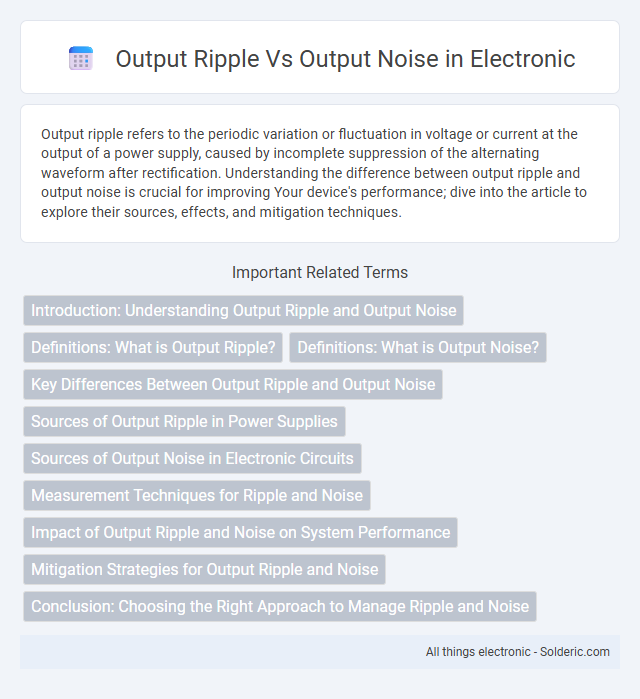Output ripple refers to the periodic variation or fluctuation in voltage or current at the output of a power supply, caused by incomplete suppression of the alternating waveform after rectification. Understanding the difference between output ripple and output noise is crucial for improving Your device's performance; dive into the article to explore their sources, effects, and mitigation techniques.
Comparison Table
| Aspect | Output Ripple | Output Noise |
|---|---|---|
| Definition | Periodic AC voltage variation superimposed on DC output | Random, high-frequency voltage variations present on output |
| Frequency | Low-frequency, typically fundamental switching or rectifier frequency | High-frequency, broadband spectral content |
| Cause | Incomplete filtering of AC components in power supplies | Electromagnetic interference (EMI), switching noise, thermal noise |
| Measurement | Measured using oscilloscope with low bandwidth | Measured using spectrum analyzer or high-bandwidth scope |
| Impact on Circuit | May cause low-frequency interference and reduce power supply quality | Can cause signal distortion, data errors, and EMI problems |
| Mitigation | Use of capacitors, inductors, and linear regulators | EMI filtering, shielding, proper PCB layout, and snubbers |
Introduction: Understanding Output Ripple and Output Noise
Output ripple represents periodic voltage fluctuations in power supplies caused by incomplete filtering of AC components, typically measured in millivolts peak-to-peak. Output noise comprises high-frequency, random voltage variations generated by electronic components and electromagnetic interference, often quantified as RMS noise voltage. Distinguishing output ripple from output noise is crucial for optimizing power supply performance and ensuring signal integrity in sensitive electronic circuits.
Definitions: What is Output Ripple?
Output ripple refers to the periodic variation or fluctuation in the DC output voltage of a power supply or regulator, typically caused by incomplete suppression of the alternating current (AC) components during the rectification and filtering process. It is characterized by a consistent, often sinusoidal, waveform at a specific frequency related to the input AC supply or switching frequency. Understanding output ripple is essential for optimizing power supply performance and minimizing interference in sensitive electronic circuits.
Definitions: What is Output Noise?
Output noise refers to the random, unpredictable fluctuations in a signal caused by inherent electronic components and external interferences, leading to deviations from the desired signal level. It typically manifests as small, high-frequency variations that degrade signal clarity and overall system performance. Unlike output ripple, which is a periodic, predictable waveform variation from power supplies, output noise is stochastic and broadband, affecting sensitive circuits such as amplifiers and ADCs.
Key Differences Between Output Ripple and Output Noise
Output ripple refers to the periodic, often AC component superimposed on a DC output, typically caused by switching elements in power supplies, whereas output noise consists of random, high-frequency fluctuations originating from electronic interference and thermal effects. Ripple usually has a predictable frequency and amplitude tied to the power supply's switching frequency, while noise is broadband and less predictable. Understanding these key differences helps you design filters and shielding to enhance power quality and maintain signal integrity in sensitive electronic applications.
Sources of Output Ripple in Power Supplies
Output ripple in power supplies primarily originates from the AC mains frequency and switching frequency of the power converter, causing periodic voltage fluctuations. Key sources include insufficient filtering capacitors, inductor saturation, and non-ideal components within the regulator circuitry. Managing Your output ripple involves optimizing filter design and component quality to minimize these voltage variations and ensure stable power delivery.
Sources of Output Noise in Electronic Circuits
Output noise in electronic circuits primarily originates from thermal noise generated by resistive elements, shot noise in semiconductor devices, and flicker noise associated with traps in transistor oxide layers. Switching regulators contribute output ripple through periodic current pulses and energy storage element charging cycles, which manifest as low-frequency voltage variations. Understanding the distinct physical mechanisms behind output ripple and noise is essential for designing effective filtering and noise reduction strategies in precision electronics.
Measurement Techniques for Ripple and Noise
Output ripple is typically measured using an oscilloscope with bandwidth limited to 20 MHz to capture periodic voltage fluctuations from power supplies, while output noise requires higher bandwidth (up to 100 MHz) to detect random high-frequency disturbances. Differential probes and proper grounding techniques are critical to minimize measurement artifacts and accurately capture ripple and noise signals. For precise quantification, measurements often involve applying bandwidth filters and statistical analysis like RMS or peak-to-peak values to distinguish ripple from noise components.
Impact of Output Ripple and Noise on System Performance
Output ripple causes periodic voltage fluctuations that can lead to timing errors and reduced efficiency in sensitive electronic circuits, while output noise introduces random disturbances that degrade signal integrity and increase bit error rates. High ripple levels can stress power management components, reducing lifespan and causing thermal instability. Minimizing both output ripple and noise is essential for optimizing system reliability, precision, and overall performance in applications such as audio processing, communications, and high-speed data converters.
Mitigation Strategies for Output Ripple and Noise
Mitigation strategies for output ripple and noise involve using low-ESR capacitors, such as ceramic or tantalum, to stabilize voltage fluctuations and reduce high-frequency noise in power supplies. Implementing proper filtering techniques, including LC or pi filters, helps smooth out ripple and attenuate unwanted noise signals effectively. Careful PCB layout with short ground loops and proper shielding minimizes electromagnetic interference, ensuring your system maintains clean and stable output signals.
Conclusion: Choosing the Right Approach to Manage Ripple and Noise
Output ripple primarily consists of low-frequency fluctuations caused by power supply switching, while output noise encompasses a broader spectrum of high-frequency disturbances originating from components and external interference. Effective management involves selecting appropriate filtering techniques such as LC filters for ripple reduction and implementing shielding or grounding strategies to minimize noise. Balancing these methods based on the specific application requirements ensures optimal power quality and system performance.
Output ripple vs Output noise Infographic

 solderic.com
solderic.com